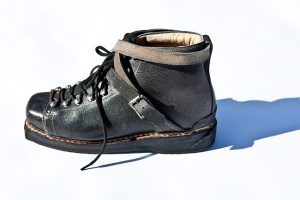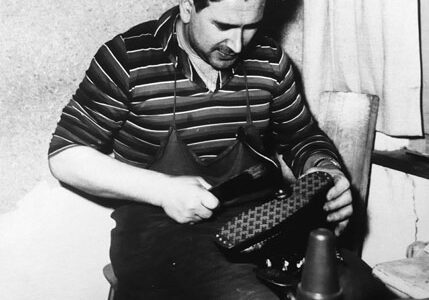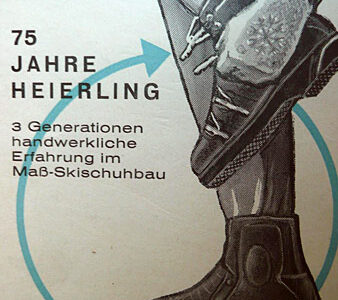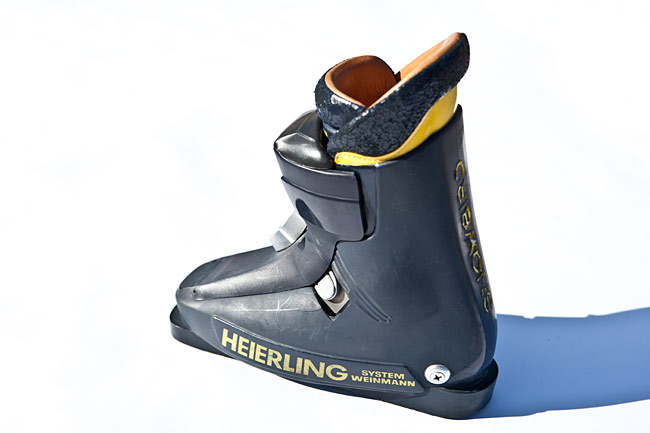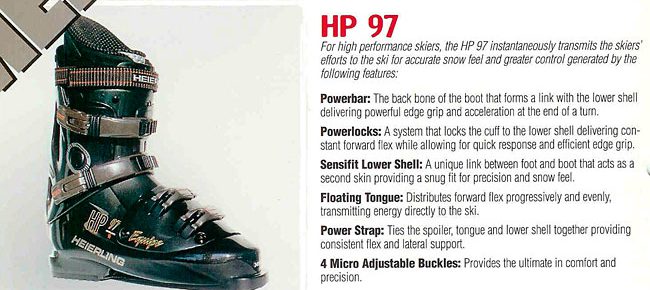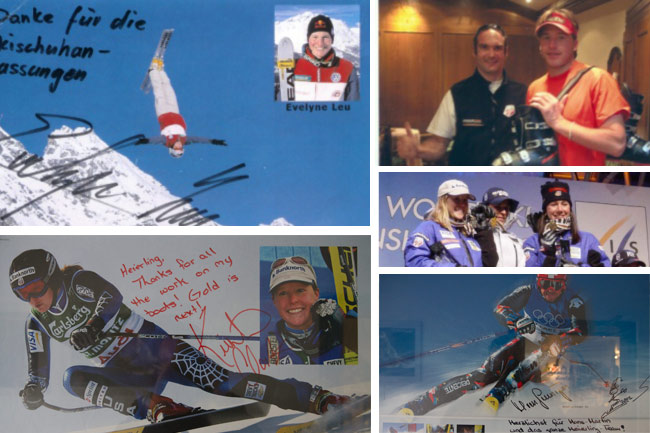We influenced the developments in the world of skiing:
The ski boot invention
Only very few know who invented the ski boot. We let you in on this with some pride in our family history, because the first ski boot ever was made by Heierling. Franz Heierling, of the first generation of Heierling entrepreneurs, produced a double stitched model and soon became the specialist in satisfying the requirements of international, world famous ski racers and ski jumpers. What followed were many medals won at olympic games by skiing professionals with Heierling ski boots. Still today, four generations later, numerous world class skiers seek out the skills and services of Heierling.
Today, as before, we work in the same spirit as company founder Franz Heierling. We allow ourselves to claim being at the forefront of technology in our field. As a small yet quality manufacturer of premium, customized ski boots, we also see ourselves as a ‘sporthopedics specialist’ – our term to describe orthopedics based customizations of ski boots and insoles, all of which goes beyond classic boot fitting.
By the way, the boot fitting concept which denotes the individual fitting of ski boots, was also first introduced by Heierling. In 1972 the ‘Hot Shot’ model appeared. It was the first custom made ski boot with a foamed liner (inner boot).
1883
Franz Heierling opens a shoe-making business, along with a shoe store, in Davos-Dorf.
At that time Davos was an up-and-coming destination for foreigners, particularly those seeking to recover from TB. Davos was developing from a small mountain village to a world-renowned health resort. Franz Heierling had 2-3 employees and most of his work consisted of shoe repairs and various types of custom-fitted shoes.
1910 – 1920
Davos continues to grow as a skiing resort and the first ski club is founded.
Hans Heierling I (1891) enters the family business and is the first to produce special sewed ski boots.
Heierling already makes specialized ski boots, with a high shaft, for ski-jumping. All ski boots are made by hand, as there is no actual production of ski boots, yet. During this time, Heierling employs 3-4 employees.
1925 – 1930
The first cable cars are built in the alps and Davos-Parsenn is known to skiers across the globe. New bindings, such as those from Huitfeld and Alpina, require new types of ski boots. In particular, boots with stronger soles are required.
Rubber soles are mounted on boots for better grip.
1934 – 1939
Heierling becomes a specialist in custom-made ski boots.
After the introduction of skiing techniques with more forward lean and rotation of the body, boots are also introduced with long lacing and higher heels. This fixes the instep into place better and allows a more optimal forward leaning position. The boot shaft is reduced to the minimum height of 12cm.
Internationally famous ski racers, such as Walter Prager, Martin Fopp and Jack Ettinger, are wearing custom-fitted racing boots from Heierling.
1948
During the first post-war Olympic Games in St. Moritz, an increasing number of ski racers come to Heierling for fitted racing boots, which have become well-known.
Emil Alias, the 1938 world champion, has Heierling outfit his entire team with boot shafts with brass reinforcements and double-shafted, double-laced, boots.
The new boots are a great success, as previous designs held the foot in place in the ankle area.
As these new, taller and stiffer boots allow much better edge grip, they are adopted by many racers.
Heierling employs 4-5 people.
1959
Heierling moves to a new shop, with adjacent offices, to the building Alpenluft, in Davos-Dorf. The workshop is now in the renovated barn next door.
1960
Almost the entire Swiss National Ski Team, as well as the USA National Ski Team, are skiing with Heierling racing ski boots.
At the Olympic Games in Squaw Valley, racers wearing Heierling boots win 3 gold and 1 silver medals, as well as 2 4th placed spots.
Heierling has definitely become a success in the ski boot industry and now employs 10 people.
1964
Ski boots with buckles are a big success.
At the Innsbruck Olympics 95% of the racers are wearing buckled boots.
Two gold and 2 silver medals are won by racers wearing Heierling boots.
Small-scale serial production is started. 2500-3000 pairs of boots are produced annually by hand.
The well-known US ski racer, Bud Werner, organised the export of Heierling boots. Employment at Heierling is up to 18 employees.
1965
Heierling begins large-scale production of a second ski boot model. Customers’ demands for less expensive boots necessitate the production of boots for the middle price segment, in addition to the exclusive, hand-made racing boots.
The new model is very successful, with 6,000 pairs already being produced.
1968
The workshop is enlarged and renovated. Heierling has 26 employees.
1972
The first steps from leather to synthetic have taken place. In addition to ski boots made with plasticized leather and injection-moulded soles, Heierling also introduces the first full-synthetic boot, Hot Shot.
This is the first custom-made ski boot with a foam-liner. Once again, Heierling is able to bring a ground-breaking product to market.
Heierling discontinues making leather shoes and closes its shoe store.
1973
Ein neues Verschluss-System der Firma Weinmann soll die herkömmlichen Schnallen ersetzen. In Zusammenarbeit mit Heierling werden erste Prototypen entwickelt und getestet.
Der erste Skischuh mit Zentralverschluss ist geboren.
Bei der Schuhproduktion kommen neuere, leichtere Kunstoffmaterialen der Firma EMS Chemie zum Einsatz.
1975 – 1976
In cooperation with Weinmann, Heierling develops the Snowbird Line, produced in Singen. This product is launched successfully world-wide under the brand name Heierling (System Weinmann).
Production in Davos is stopped and moved to Yugoslavia, Italy and Singen, Germany.
1978 – 1980
Annual production increases to 45,000 pairs of ski boots and 12,000 pairs of hiking boots. A new warehouse and logistics are built up.
A cross country skiing line is introduced.
1982
Weinmann begins to brand ski boots with the twist closure under its own name and Heierling is now the agent for Switzerland and Lichtenstein.
Hans-Martin Heierling (1964) is studying orthopaedic shoe-making, thereby being the 4th generation to ensure the continuation of the Heierling business.
1983
Thomas Heierling opens a new company called Sportschuh-Fitting-Center, at the same location as Heierling AG used to be.
This business reactivates Heierling’s original core business – making custom-built ski boots.
Again, foam-liners are used.
Heierling AG now produces 90,000 pairs of ski boots, 160,000 pairs of cross country ski boots and approximately 15,000 pairs of hiking/leisure boots annually.
1984 – 1987
Hans-Martin Heierling, now finished with his studies, also starts working at Sportschuh-Fitting-Center and the brothers Thomas and Hans-Martin Heierling form a general partnership.
The Fitting Center has an increasing number of non-racing clients. As well, many ski racers take advantage of Heierling’s know-how and get their boots fitted here.
Lighter, cold-resistant synthetic materials are increasingly used and rear-entry boot models are introduced. For various reasons, sales of models with the Weinmann twist closure are decreasing.
Big changes in the winter sporting equipment market are creating a highly competitive environment and making the sale of serial-produced goods increasingly difficult.
2000 – 2004
The Heierling brother’s Fitting-Center is becoming increasingly well-known and acquiring a growing customer base.
The Heierling Salomon Racing Center is established.
The success of the “golden age of Heierling” returns and World Cup athletes from various nations win medals while racing with boots fitted by Heierling.
2013
Hans-Martin Heierling develops and launches the Swiss made Heierling h1 skiboot.
New technologies such as the temperature resistant material Templast including a shock-absorbing wedge produced from Swiss ash are being introduced.
2014 – 2015
The Heierling h1 skiboot is being introduced by leading retail stores in Switzerland, Austria, France and the United States.
Heierling is dedicated to continuing its 130-year-old tradition of excellence in boot-making. Heierling is still a family owned business in its fourth generation located in Davos/Switzerland.
The Passion of Family Tradition.








